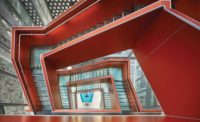Dave Mulholland, VHB southeast regional manager, says Florida is "the perfect storm" for testing big data. "It combines urban and rural roads and highways, extreme weather and a wide mix of drivers," he observes. He points out that big data is just data unless you can find a way to use it productively. "What we need to build is a platform to identify and assess safety threats in real time. That is where you get the big data payoff."
Searching for the Next Generation
Staffing is once again a problem, causing many design firms to scramble to find talent. "One significant trend we see across the architecture industry is a shortage of manpower in the marketplace," says Katherine Peele, executive vice president of LS3P. She says this shortage is particularly noticeable at certain experience levels because, during the recession, so many young designers left the profession and sought work in other industries.
"Baby boomers' retirement has an enormous impact on the industry. While we have foreseen this generational transition for some time, we are now in the midst of it and fully feeling its effect," says Glenn Bell, CEO of Simpson Gumpertz & Hager. "The best practices I have seen are by companies transitioning their baby-boomer leaders early while still finding roles for them post-transition."
For some firms, the ability to recruit experienced staff has not yet been much of a problem. "Given all the major mergers and acquisitions, there are experienced people leaving these megafirms to find a less bureaucratic, more entrepreneurial place to work," says Vincze. He says TRC, with a staff of 3,500, is relatively smaller and more able to provide designers an opportunity to grow.
"Prerecession, staffing was the industry's biggest problem," says Batrack of Tetra Tech. However, he says the recession pushed a lot of engineers out of the buildings market, with some moving to the infrastructure side. Further, federal sequestration caused layoffs in the federal sector, and the latest spurt of mergers and acquisitions have resulted in staff cuts. "So, we have not experienced severe shortages in the availability of experienced professional and technical staff yet," he says.
However, Bishop of AECOM says the fallout from the AECOM-URS merger was not big. "The rationalization between the two firms was quite small. The layoffs amounted to less than 2% on the professional side and even less among our technical staff." Bishop says AECOM now is looking to fill about 1,000 vacancies. "Most clients want people with at least five years' experience, so we are recruiting young people to prepare for future work five to 10 years down the road."
Burns & McDonnell also is looking to hire, but it is focusing on new graduates, rather than experienced engineers. "We have an extensive internship program [in which] young people in school can give us a test drive just as we give them a test drive before hiring them full time," says Graves. He says the firm hopes to hire 200 to 300 new grads a year.
However, hiring experienced engineers can be risky. "It is hard to determine whether they will be a good fit until after you hire them," Graves says. The expense of hiring them and disruptions to the organization can be great if a high-level engineer does not work out, he says.
Attracting young talent is causing some design firms to make changes. For example, Kleinfelder recently moved its headquarters from the suburbs to downtown San Diego. "Younger people want to live and work in an urban environment where there is more activity," says Bill Siegel, CEO. He also notes that public agencies want more of their dollars going to local entities.So, there are significant business reasons to move offices into the cities design firms serve.
Too Much Technology?
Technological advances continue to improve design firms' productivity. However, the process often becomes frustrating. "We are constantly bombarded with products that claim to enhance our sales or productivity, and it is a major effort to determine which will work for us," says Graves. "We need to focus on technologies that work in our space and not get drowned in dozens of different approaches and platforms."
Another issue that design firms have to deal with is the security of their own data. "Confidentiality agreements with increasingly more severe penalties have proliferated in all aspects of our practice," says Kevin Gordon, principal at tvsdesign. "With the acceptance of cloud services for transmittal, storage and printing, information security may become a more pressing requirement in an industry that has a history of relative openness and an impatience for steps necessary to reduce downstream risk."
Wager cautions that there are other concerns regarding client data. He says security to protect against cyberattacks on infrastructure systems has been growing. Much of this effort has focused on attacks by terrorists or other hostile entities.
But Wager says there is another area that warrants concern: identity thieves. He notes that many public agencies now have electronic tolling that is tied directly to commuter credit cards. "Financial institutions and credit-card companies spend fortunes to protect customer information. Now, transit agencies will need to get up to speed, as well," Wager says.
AECOM employed technology in a novel fashion. "Working on Australia's offshore gas projects, we were required by environmental regulations to do counts of marine mammals to make sure our work did not affect their habitat," says Bishop. Working with planes and physically counting mammals was expensive and not as accurate as anyone would like. "AECOM's drone technology allowed us to hover over the mammal populations and do the count remotely. It was a lot cheaper and much more accurate," he says.
Siegel of Kleinfelder says societal changes and technology are changing the design market in subtle ways. "Low-flow water fixtures are saving water in buildings but are also forcing changes in the way we design wastewater treatment plants. More-efficient cars are saving fuel and improving air quality but are cutting receipts from the gas tax, forcing us to find new ways to finance transportation. A more efficient grid is eliminating waste but cutting down on the need for new powerplants." He says there are unforeseen consequences to every major development in the design world and that design firms must be prepared to adapt to both new technologies and their unforeseen impacts.






Post a comment to this article
Report Abusive Comment